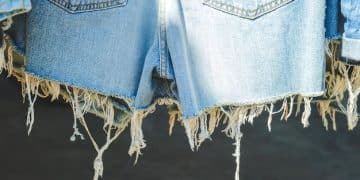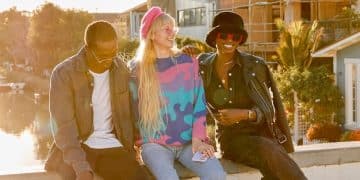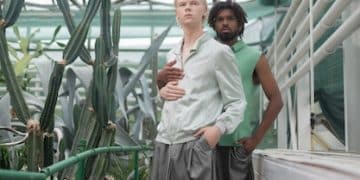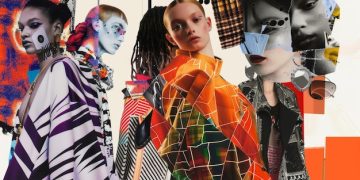Alternative Fashion in the US: Top 3 Underground Trends for 2025
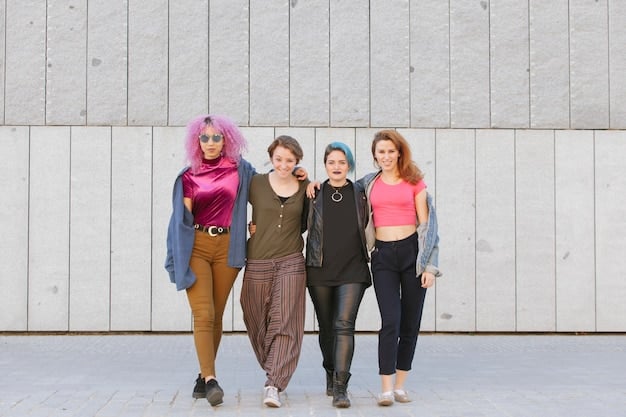
Alternative fashion in the US is undergoing a vibrant transformation, with underground designers leading the way. In the next six months, expect to see a surge in sustainable punk, deconstructed streetwear, and tech-infused garments, all reflecting a desire for individuality and conscious consumption.
Get ready to redefine your style! Alternative fashion in the US: 3 Key Trends Emerging from Underground Designers in the Next 6 Months is set to explode with innovation, individuality, and a rebellious spirit. Discover the cutting-edge styles that are about to dominate the underground scene and reshape mainstream fashion.
Sustainable Punk Revival
The punk ethos of rebellion and DIY is merging with a growing awareness of environmental issues. This is leading to a sustainable punk movement that prioritizes repurposed materials, vintage finds, and ethical production practices.
Designers are reimagining classic punk elements with an eco-conscious twist, breathing new life into discarded garments and promoting a more sustainable approach to fashion.
Upcycled Denim and Leather
Denim and leather, staples of punk fashion, are being upcycled into unique and edgy pieces. Designers are deconstructing and reconstructing these materials, creating one-of-a-kind jackets, vests, and skirts that are both stylish and sustainable.
DIY Embellishments and Patches
Personalization is key in the sustainable punk movement. DIY embellishments such as patches, studs, and hand-painted designs allow individuals to express their creativity and add a personal touch to their clothing.
- Repurposed fabrics
- Vintage clothing alterations
- Hand-painted designs on jackets
- Patches made from recycled materials
Sustainable punk is more than just a trend; it’s a statement about conscious consumption and a rejection of fast fashion’s unsustainable practices. By embracing upcycled materials and DIY embellishments, individuals can express their unique style while minimizing their environmental impact.
Deconstructed Streetwear Takes Center Stage
Streetwear is evolving beyond its sporty roots, embracing deconstruction and asymmetry to create visually striking and intellectually stimulating designs.
Underground designers are challenging traditional notions of garment construction, pushing boundaries and creating pieces that are both wearable and thought-provoking.
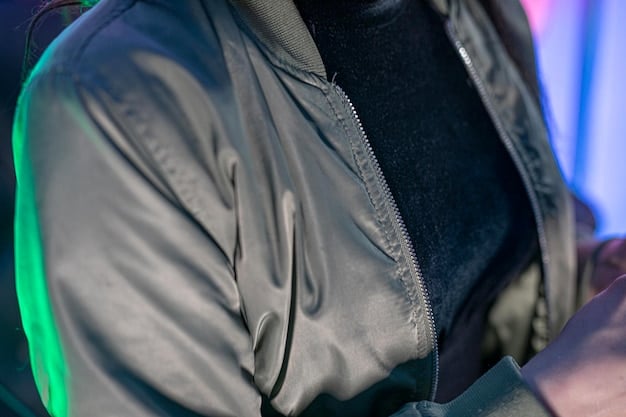
Asymmetrical Cuts and Layering
Asymmetrical cuts and layering are central to the deconstructed streetwear aesthetic. Garments are designed with uneven hemlines, off-center closures, and unexpected fabric combinations, creating a sense of visual imbalance and dynamic movement.
Visible Seams and Raw Edges
Exposing the inner workings of garments is a key element of deconstructed streetwear. Visible seams, raw edges, and unfinished details reveal the construction process, adding a raw and industrial feel to the designs.
- Deconstructed hoodies with exposed zippers
- Wide-leg pants with unfinished hems
- Oversized shirts with mismatched sleeves
- Layered tops with visible seams
Deconstructed streetwear is about more than just aesthetics; it’s a reflection of a society that is constantly evolving and questioning established norms. By embracing unconventional designs and construction techniques, designers are creating pieces that challenge our perceptions of fashion and identity.
Tech-Infused Fashion for the Digital Age
As technology becomes increasingly integrated into our lives, it’s natural that it would also find its way into fashion. Underground designers are exploring the possibilities of tech-infused garments, creating pieces that are both functional and futuristic.
From interactive displays to wearable sensors, technology is being used to enhance the wearer’s experience and create a more personalized and connected relationship with their clothing.
Interactive Displays and LED Lighting
Some designers are incorporating interactive displays and LED lighting into their garments, allowing the wearer to customize the appearance of their clothing with the touch of a button. These displays can be programmed to show patterns, animations, or even real-time information, creating a dynamic and engaging visual experience.
Wearable Sensors and Smart Fabrics
Wearable sensors and smart fabrics are being used to track the wearer’s biometrics, providing valuable data about their health and well-being. This data can be used to adjust the garment’s temperature, monitor their activity levels, or even provide personalized recommendations.
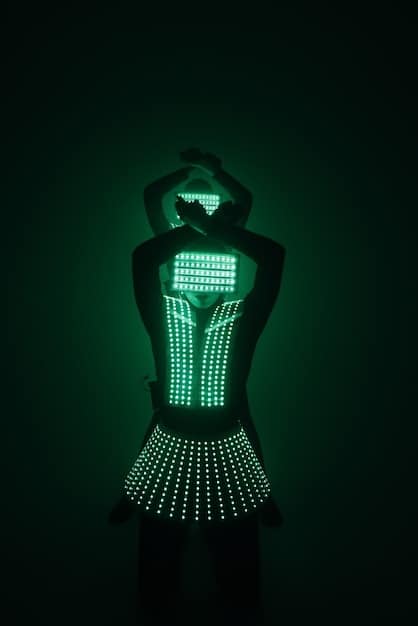
- Jackets with built-in solar panels to charge devices
- Gloves with haptic feedback for gaming
- Shoes with GPS tracking and navigation
- Clothing that changes color based on mood
Tech-infused fashion is still in its early stages, but it has the potential to revolutionize the way we interact with our clothing and the world around us. As technology continues to advance, we can expect to see even more innovative and exciting applications of technology in fashion.
The Rise of Gender-Neutral Garments
The rigid boundaries of traditional gendered clothing are dissolving as alternative fashion designers champion inclusivity. This movement embraces garments designed to be worn by anyone, regardless of gender identity.
Focus will be on freeing fashion from conventional limitations, prioritizing comfort, style, and personal expression over outdated norms.
Fluid Silhouettes and Versatile Pieces
Designers are creating fluid silhouettes that defy traditional notions of masculinity and femininity. Versatile pieces, such as oversized tunics, wide-leg pants, and androgynous jackets, can be styled in various ways to suit individual preferences.
Neutral Color Palettes and Minimalist Designs
Gender-neutral garments often feature neutral color palettes and minimalist designs, allowing the wearer to focus on the shape and fit of the clothing rather than gendered details. This approach creates a blank canvas for self-expression through accessories and personal styling.
- Unisex jumpsuits in earth tones
- Oversized sweaters with gender-neutral patterns
- Wide-leg pants suitable for all body types
- Minimalist jackets with clean, simple lines
The rise of gender-neutral garments signifies a shift towards a more inclusive and accepting fashion landscape. By challenging traditional gender norms, designers are empowering individuals to express themselves authentically and freely.
DIY Customization and Personalization
In response to mass-produced fashion, alternative designers are emphasizing DIY customization and personalization. This trend encourages individuals to take an active role in shaping their own style.
Emphasis will be on individuality, enabling wearers to transform basic garments into unique, personalized creations through various techniques.
Embellishments, Patches, and Artwork
Designers provide blank canvases in the form of simple garments that wearers can then embellish with patches, artwork, and other personal touches. This allows for limitless creativity and self-expression.
Upcycling and Alterations
Transforming old clothes into new, stylish pieces is a popular form of DIY customization. Wearers can alter the fit, add new details, or combine multiple garments to create a unique and sustainable look.
- Denim jackets adorned with hand-painted designs
- T-shirts featuring stenciled graphics
- Bags customized with unique patches and pins
- Altered vintage dresses with modern twists
DIY customization and personalization empower individuals to reject conformity and embrace their unique style. This trend fosters creativity, sustainability, and a deeper connection with one’s clothing.
Ethical and Sustainable Sourcing
Conscious consumerism is driving demand for ethical and sustainable sourcing in alternative fashion. Designers are increasingly committed to transparency and responsible practices.
Emphasis will be on eco-friendly materials, fair labor practices, and reducing waste throughout the supply chain.
Organic, Recycled, and Upcycled Materials
Designers are prioritizing the use of organic cotton, recycled polyester, and upcycled fabrics to minimize their environmental impact. These materials offer a sustainable alternative to conventional textiles.
Fair Labor Practices and Transparent Supply Chains
Ensuring fair wages and safe working conditions for garment workers is a top priority. Designers are working to establish transparent supply chains that allow consumers to trace the origin of their clothing and verify ethical practices.
- Clothing made from hemp and bamboo fibers
- Accessories crafted from recycled plastic bottles
- Dyes derived from natural sources
- Transparent sourcing information for all materials
Ethical and sustainable sourcing reflects a growing awareness of the social and environmental impact of fashion. By supporting designers who prioritize responsible practices, consumers can contribute to a more just and sustainable industry.
| Key Trend | Brief Description |
|---|---|
| ♻️ Sustainable Punk | Eco-conscious punk with repurposed materials and DIY embellishments. |
| 🔪 Deconstructed Streetwear | Asymmetrical cuts, visible seams, and raw edges for a raw aesthetic. |
| 💡 Tech-Infused Fashion | Garments with interactive displays, LED lighting, and wearable sensors. |
| 🚻 Gender-Neutral | Clothing designed to be worn by anyone, regardless of gender identity. |
FAQ
▼
Alternative fashion encompasses styles that deviate from mainstream trends, often reflecting subcultures, individuality, and unique self-expression. It’s about breaking norms and embracing unconventional aesthetics.
▼
Look to independent boutiques, online platforms specializing in emerging designers, and art-driven markets and festivals that showcase unique and boundary-pushing fashion creations.
▼
Opt for clothing made from recycled materials, shop at vintage stores, support brands with ethical production, and embrace DIY upcycling and customization to reduce waste and express your values.
▼
Technology is integrating into alternative fashion via interactive displays, LED lighting, and wearable sensors, enhancing functionality and personalizing the wearer’s connection with their garments.
▼
Gender neutrality reflects a cultural shift towards inclusivity and self-expression. It allows individuals to bypass traditional gender expectations and embrace garments that suit their unique identities and preferences.
Conclusion
The alternative fashion scene in the US is set to be energized by sustainable punk, deconstructed streetwear, and tech-infused garments. These trends, driven by underground designers, reflect a move towards individuality, sustainability, and a rejection of mainstream norms, promising a more exciting and personalized fashion future.
